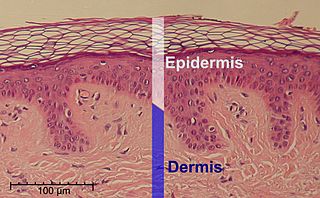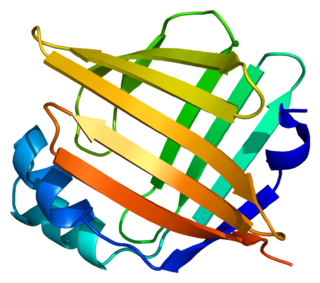Related Research Articles

Keratinocytes are the primary type of cell found in the epidermis, the outermost layer of the skin. In humans, they constitute 90% of epidermal skin cells. Basal cells in the basal layer of the skin are sometimes referred to as basal keratinocytes. Keratinocytes form a barrier against environmental damage by heat, UV radiation, water loss, pathogenic bacteria, fungi, parasites, and viruses. A number of structural proteins, enzymes, lipids, and antimicrobial peptides contribute to maintain the important barrier function of the skin. Keratinocytes differentiate from epidermal stem cells in the lower part of the epidermis and migrate towards the surface, finally becoming corneocytes and eventually be shed off, which happens every 40 to 56 days in humans.

The epidermis is the outermost of the three layers that comprise the skin, the inner layers being the dermis and hypodermis. The epidermis layer provides a barrier to infection from environmental pathogens and regulates the amount of water released from the body into the atmosphere through transepidermal water loss.

Keratin, type I cytoskeletal 4 also known as cytokeratin-4 (CK-4) or keratin-4 (K4) is a protein that in humans is encoded by the KRT4 gene.

Desmoglein-3 is a protein that in humans is encoded by the DSG3 gene. In the skin epidermis Desmoglein-3 is expressed in the basal lower layers of the epidermis, and dominates in terms of expression on mucosal surfaces compared to Desmoglein-1.
Sphingosine-1-phosphate (S1P) is a signaling sphingolipid, also known as lysosphingolipid. It is also referred to as a bioactive lipid mediator. Sphingolipids at large form a class of lipids characterized by a particular aliphatic aminoalcohol, which is sphingosine.
Corneocytes are terminally differentiated keratinocytes and compose most of the stratum corneum, the outermost layer of the epidermis. They are regularly replaced through desquamation and renewal from lower epidermal layers and are essential for its function as a skin barrier.

S100 calcium-binding protein A2 (S100A2) is a protein that in humans is encoded by the S100A2 gene and it is located on chromosome 1q21 with other S100 proteins.

Dystonin(DST), also known as bullous pemphigoid antigen 1 (BPAG1), isoforms 1/2/3/4/5/8, is a protein that in humans is encoded by the DST gene.

Involucrin is a protein component of human skin and in humans is encoded by the IVL gene. In binding the protein loricrin, involucrin contributes to the formation of a cell envelope that protects corneocytes in the skin.

Calcium-transporting ATPase type 2C member 1 is an enzyme that in humans is encoded by the ATP2C1 gene.

Fibroblast growth factor 10 is a protein that in humans is encoded by the FGF10 gene.

Fatty acid-binding protein, epidermal is a protein that in humans is encoded by the FABP5 gene.

Small proline-rich protein 3 is a protein that in humans is encoded by the SPRR3 gene, which is found within the epidermal differentiation complex (EDC).

Caspase 14 is an enzyme that in humans is encoded by the CASP14 gene.

Cytochrome P450 26A1 is a protein that in humans is encoded by the CYP26A1 gene.

Keratin, type I cuticular Ha1 is a protein that in humans is encoded by the KRT31 gene.

Cornifin-A is a protein that in humans is encoded by the SPRR1A gene.

Dermatopontin also known as tyrosine-rich acidic matrix protein (TRAMP) is a protein that in humans is encoded by the DPT gene. Dermatopontin is a 22-kDa protein of the noncollagenous extracellular matrix (ECM) estimated to comprise 12 mg/kg of wet dermis weight. To date, homologues have been identified in five different mammals and 12 different invertebrates with multiple functions. In vertebrates, the primary function of dermatopontin is a structural component of the ECM, cell adhesion, modulation of TGF-β activity and cellular quiescence). It also has pathological involvement in heart attacks and decreased expression in leiomyoma and fibrosis. In invertebrate, dermatopontin homologue plays a role in hemagglutination, cell-cell aggregation, and expression during parasite infection.

Sciellin is a protein that in humans is encoded by the SCEL gene.
A Muse cell is an endogenous non-cancerous pluripotent stem cell. They reside in the connective tissue of nearly every organ including the umbilical cord, bone marrow and peripheral blood. They are collectable from commercially obtainable mesenchymal cells such as human fibroblasts, bone marrow-mesenchymal stem cells and adipose-derived stem cells. Muse cells are able to generate cells representative of all three germ layers from a single cell both spontaneously and under cytokine induction. Expression of pluripotency genes and triploblastic differentiation are self-renewable over generations. Muse cells do not undergo teratoma formation when transplanted into a host environment in vivo. This can be explained in part by their intrinsically low telomerase activity, eradicating the risk of tumorigenesis through unbridled cell proliferation. They were discovered in 2010 by Mari Dezawa and her research group. Clinical trials for acute myocardial infarction, stroke, epidermolysis bullosa, spinal cord injury, amyotrophic lateral sclerosis, acute respiratory distress syndrome (ARDS) related to novel coronavirus (SARS-CoV-2) infection, are conducted by Life Science Institute, Inc., a group company of Mitsubishi Chemical Holdings company. Physician-led clinical trial for neonatal hypoxic-ischemic encephalopathy was also started. The summary results of a randomized double-blind placebo-controlled clinical trial in patients with stroke was announced.
References
- ↑ Boukamp, Petra; Petrussevska, Rule T.; Breitkreutz, Dirk; Hornung, Jiirgen; Markham, Alex; Fusenig, Norbert E. (1 March 1988). "Normal keratinization in a spontaneously immortalized aneuploid human keratinocyte cell line". The Journal of Cell Biology. 106 (3): 761–771. doi:10.1083/jcb.106.3.761. PMC 2115116 . PMID 2450098.
- ↑ Ölschläger, Veronika; Schrader, Andreas; Hockertz, Stefan (13 December 2011). "Comparison of Primary Human Fibroblasts and Keratinocytes with Immortalized Cell Lines Regarding their Sensitivity to Sodium Dodecyl Sulfate in a Neutral Red Uptake Cytotoxicity Assay". Arzneimittelforschung. 59 (3): 146–152. doi:10.1055/s-0031-1296378. PMID 19402346.
- ↑ Schoop, Veronika M.; Fusenig, Norbert E.; Mirancea, Nicolae (March 1999). "Epidermal Organization and Differentiation of HaCaT Keratinocytes in Organotypic Coculture with Human Dermal Fibroblasts". Journal of Investigative Dermatology. 112 (3): 343–353. doi: 10.1046/j.1523-1747.1999.00524.x . PMID 10084313.
- ↑ Schürer, N; Köhne, A; Schliep, V; Barlag, K; Goerz, G (Aug 1993). "Lipid composition and synthesis of HaCaT cells, an immortalized human keratinocyte line, in comparison with normal human adult keratinocytes". Experimental Dermatology. 2 (4): 179–85. doi:10.1111/j.1600-0625.1993.tb00030.x. PMID 8162337.
- ↑ Lehmann, Bodo (1 January 1997). "HaCaT Cell Line as a Model System for Vitamin D3 Metabolism in Human Skin". Journal of Investigative Dermatology. 108 (1): 78–82. doi: 10.1111/1523-1747.ep12285640 . PMID 8980292.